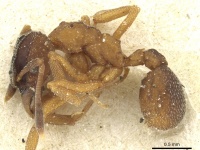Mycetophylax daguerrei
| Mycetophylax daguerrei | |
|---|---|

| |
| Scientific classification | |
| Kingdom: | Animalia |
| Phylum: | Arthropoda |
| Class: | Insecta |
| Order: | Hymenoptera |
| Family: | Formicidae |
| Subfamily: | Myrmicinae |
| Tribe: | Attini |
| Genus: | Mycetophylax |
| Species: | M. daguerrei |
| Binomial name | |
| Mycetophylax daguerrei (Santschi, 1933) | |
Nothing is known about the biology of this species.
Identification
See description section below.
Distribution
Latitudinal Distribution Pattern
Latitudinal Range: -29.7° to -34.583333°.
| North Temperate |
North Subtropical |
Tropical | South Subtropical |
South Temperate |
- Source: AntMaps
Distribution based on Regional Taxon Lists
Neotropical Region: Argentina (type locality).
Distribution based on AntMaps
Distribution based on AntWeb specimens
Check data from AntWeb
Countries Occupied
| Number of countries occupied by this species based on AntWiki Regional Taxon Lists. In general, fewer countries occupied indicates a narrower range, while more countries indicates a more widespread species. |

|
Estimated Abundance
| Relative abundance based on number of AntMaps records per species (this species within the purple bar). Fewer records (to the left) indicates a less abundant/encountered species while more records (to the right) indicates more abundant/encountered species. |

|
Biology
|
Castes
Nomenclature
The following information is derived from Barry Bolton's Online Catalogue of the Ants of the World.
- daguerrei. Cyphomyrmex (Cyphomyrmex) daguerrei Santschi, 1933e: 118 (w.) ARGENTINA.
- Combination in Mycetophylax: Sosa-Calvo et al., 2017: 9.
- See also: Kempf, 1964d: 28.
Description
Kempf (1964) - When describing daguerrei, Santschi compared it with Cyphomyrmex morschi (=Mycetophylax morschi). There is, indeed, a certain resemblance, evident principally in the following characters: Scape long, well projecting beyond occipital lobes or corners; hind femora slender, not dilated nor visibly carinate ventrally at basal third, their length exceeding the head length; clypeal teeth feebly if at all developed. These characters likewise separate daguerrei from the remaining forms of the olitor-subgroup. A few stray specimens from southeastern Brazil, which I provisionally associate with Mycetophylax olitor approach daguerrei rather closely, except for the just mentioned critical characters, and the evenly rounded frontal lobes, the subparallel frontal carinae.
On the other hand, the deeply notched anterior border of clypeus, the more distinctly circumscribed antennal scrobe, the marked occipital angles, the better developed thoracic tubercles, the steeper face of epinotum, the shorter and broader postpetiole with more strongly diverging sides in full-face view, are useful features for distinguishing daguerrei from morschi.
Worker
Kempf (1964) - Lectotype. Total length 3.4 mm; head length 0.80 mm; head width 0.75 mm; maximum diameter of eyes 0.13 mm; scape length 0.67 mm; thorax length 1.01 mm; hind femur length 0.85 mm. Medium brown; dorsum of head, postpetiole and gaster infuscated. Opaque; finely reticulate-punctate; antennal scrobe reticulate-punctate, slightly shining; front reticulate-rugose; postpetiole and gaster with dense larger shallow foveolae. The whole insect covered with whitish, fine, decumbent, scattered and glittering hairs, becoming subdecumbent or recurved on head and gaster. Tip of gaster with the usual dense fringe of short erect hairs.
Head (fig 8). Mandibles finely punctate and vestigially striolate; chewing border with 8 teeth, gradually diminishing in size toward base. Clypeus with anterior border convex and projecting, noticeably excised in middle; lateral denticle at origin of frontal carinae at best vestigial. Frontal area distinct, longer than broad. Frontal carinae with moderately expanded frontal lobes, somewhat diverging caudad and feebly sinuous after constriction. Preocular carinae reaching occipital corner, completely closing the antennal scrobe. Occiput broadly and shallowly excised with another narrower and deeper median excision, between distinct carinae of vertex. Supraocular tumulus blunt but prominent. Scapes in repose surpassing marked occipital corners by a distance equaling their apical width. Funicular segments II-IV a little longer than broad, V-VII about as broad as long.
Thorax (fig 22). Pronotum with a pair of projecting and conical tubercles on each side; midpronotal tubercle well-developed but rather blunt; antero-inferior corner with an obliquely truncate foliaceous tooth. Mesonotum with 2 pairs of longitudinal ridges, appearing in side view as obtuse, low triangular teeth; area between ridges flattened to slightly excavate. Mesoepinotal groove deeply impressed. Basal face of epinotum laterally weakly marginate, posteriorly with a pair of small pointed teeth. Hind femora simple, not dilated nor longitudinally crested ventrally on basal third.
Pedicel (fig 22, 34). Petiolar node broader than long, slightly broader with rounded corners in front; anterior face distinct from dorsal face, the latter delimited laterally by longitudinal carinules and posteriorly by a slightly raised transverse laminule. Postpetiole subtrapezoidal, somewhat broader than long, (11:9), dorsum with a deep longitudinal furrow, postero-lateral corners narrowly foliaceous and not appressed to sternum. First tergite of gaster with shallow, mid-dorsal longitudinal furrow in front; lateral borders submarginate on anterior two thirds.
The paratype worker has the following measurements; head length 0.83 mm; head width 0.75 mm; scape length 0.72 mm; thorax length 1.07 mm; hind femur length 0.85 mm. It is otherwise completely identical with lectotype. The denticle at origin of frontal carinae is still weaker, nearly obsolete. Figures based on paratype specimen, deposited in my collection (WWK).
Type Material
Kempf (1964) - 3 workers collected by J. B. Daguerre, n. 1903-667. Two workers examined (lectotype and paratype NHMB and WWK) received from Santschi collection.
References
- Kempf, W. W. 1964d. A revision of the Neotropical fungus-growing ants of the genus Cyphomyrmex Mayr. Part I: Group of strigatus Mayr (Hym., Formicidae). Stud. Entomol. 7: 1-44 (page 28, see also)
- Santschi, F. 1933f. Fourmis de la République Argentine en particulier du territoire de Misiones. An. Soc. Cient. Argent. 116: 105-124 (page 118, worker described)
- Sosa-Calvo, J., JesÏovnik, A., Vasconcelos, H.L., Bacci, M. Jr., Schultz, T.R. 2017. Rediscovery of the enigmatic fungus-farming ant "Mycetosoritis" asper Mayr (Hymenoptera: Formicidae): Implications for taxonomy, phylogeny, and the evolution of agriculture in ants. PLoS ONE 12: e0176498 (DOI 10.1371/journal.pone.0176498).




